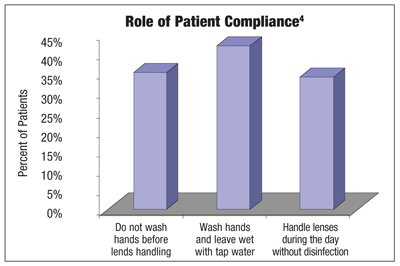 All eye care practitioners want their lens-wearing patients to feel as comfortable as possible in their contact lenses. We continue to offer the newest innovations in contact lens materials, and because contact lenses are a prescribed product, we are confident in the lenses we choose for each patient. But, how certain are we about the care system patients are using and the way they are caring for their lenses?
All eye care practitioners want their lens-wearing patients to feel as comfortable as possible in their contact lenses. We continue to offer the newest innovations in contact lens materials, and because contact lenses are a prescribed product, we are confident in the lenses we choose for each patient. But, how certain are we about the care system patients are using and the way they are caring for their lenses?
Prescribe Care Systems
Research has demonstrated the impact that contact lens care systems can have on the comfort of lens wear.1,2 As we learn more about silicone hydrogel contact lenses, the way they interact with the ocular surface and the solutions that are used, it has become increasingly important to fully understand the care systems that our patients are utilizing.
So, what care system are our patients using, and are they adhering to our recommendations? Many practitioners state that their patients seem to be taking this decision into their own hands. In a recent survey of eye care practitioners, none admitted to recommending store brand or generic contact lens solutions to their patients. Yet when market share of current units sold were analyzed, over 30% of the solutions sold were store brand solutions.3 There is a large disconnect between what eye care practitioners are recommending and what patients are actually purchasing.
There could be multiple reasons for this discrepancy. Patients who stray from doctor recommendations may not have received proper education from their eye care provider. Starter kits given at the end of an examination may provide an implied recommendation, but unless that message is reinforced, our patients will not understand the importance of using any particular contact lens care solution or place any value on it. Sometimes writing the name of a contact lens care system on a prescription pad will resonate significantly more with the patient. You can also use coupons as a way of reinforcement of the care system that your have selected.
Without properly educating our patients, they will often make a decision based on price. Unfortunately, after all the time and expertise that was used to create a proper contact lens fit that maximizes comfort and vision, this patient decision may lead to a poor experience with their contact lens wear.
Confirm Proper Cleaning

This graph shows patient compliance with hand washing prior to lens
handling.
As many as 35% of patients don’t even wash their hands before handling their contact lenses.4 Also, contact lenses become up to eight times cleaner when they are rubbed.5 In addition to sticking with the specific contact lens care system, adhering to the proper lens care regimen is also a very important factor.
Significant research has been done in the area of understanding the care habits of contact lens wearers. Up to 90% of contact lens wearers are non-compliant with their lens wear and care, and only 16% of contact lens wearers perform the rub, rinse and soak steps of lens disinfection.4 Additionally, the Contact Lens Council found that 44% of contact lens wearers always or occasionally top off (re-use) their contact lens solution.5
Unfortunately, there is a significant amount of apathy that exists with patients when it comes to proper contact lens wearing habits. It is our professional responsibility to deliver a consistent message to them on the importance of proper lens wear and care.
Boost Compliance
When questioned, many patients will often tell eye care practitioners what they think the right answers are supposed to be. For example, “I replace my contact lenses when I am supposed to, use the solutions that you recommended, and rub and rinse my contact lenses every night before storing them in fresh solution.” These are the obvious “right” answers, but in many cases, they aren’t representative of what the patient actually does.
While promoting compliance is not an easy feat, it is not impossible. Here are some strategies that we have found helpful when trying to re-emphasize the importance of contact lens care:
• Ask your patients to bring in their contact lens case, solution and any other products they use to care for their lenses. This request can be made when they initially schedule their appointment and again when their appointment is confirmed. This will give you greater insights into patients’ actual contact lens care habits.
• When taking a thorough history, use pointed questions to determine if patients are washing their hands, rubbing their lenses, replacing their solution daily and cleaning their case regularly.
• When discussing the reasons for using certain solutions and following certain steps when cleaning and disinfecting lenses, try to make the message simple, but leave a lasting impression. This is how we describe contact lens care to a typical lens wearer: “I never want comfort to limit your ability to wear contact lenses successfully, which is why I want you to use this particular contact lens care system. When you take your contact lenses out, I want you to rub your contact lenses in the palm of your hand and then rinse all of the debris off of the contact lens with the solution. Then, store the contacts in fresh solution that you have just put in the case. By utilizing the solution that I recommended and following these steps, we will minimize the chance of discomfort that may limit your ability to wear contact lenses comfortably.”
A Case In Point

1. This patient failed
to replace her contact lens solution for one week. We see a clear line
made in the contact lens case demarcating where the contact lens
solution was present in the well.
“Emily,” a 49-year-old female is a pseudophake O.U. She had worn contact lenses in the past but had depended on reading glasses to correct her near vision since her cataract surgery. In the past few years, this has become cumbersome for her, so she wants to know if she has contact lens options that will help her see better at near. She was fit in a multifocal contact lens, but because of her prior history of successful contact lens wear, I neglected to re-educate her on proper care habits with her contact lenses.
I saw Emily one week after wearing the lenses, and she complained of uncomfortable contact lens wear. She brought in her contact lens solution and case. Figure 1 shows the inside of one of the wells of the contact lens case. There is a clear demarcated line consistent with the height of the contact lens solution. When asked how she cared for her contact lenses, she said that she took them out and put them in her contact lens case. She denied rubbing or rinsing the contact lenses, and when asked how often she replaced the contact lens solution in her case, she looked at me with a surprised look and responded, “I was supposed to replace the solution?”
Emily was re-educated on proper contact lens care, provided with a new pair of diagnostic lenses and was seen back the following week. Not surprisingly, her comfort had improved significantly. This case shows that even the smallest changes in care habits can make significant improvements in the performance of contact lenses, helping to derail dropouts!
1. Potter B, Stiegemeier M, Movic W, et al. A clinical evaluation of solutions. RCCL. 2005 Nov:2-5.
2. Corbin G, Bennett L, Espejo L, et al. Comfort associated with a marketed contact lens care solution. Poster presented at AOA. June 2009. Washington, DC.
3. Alcon, data on file.
4. Stone R. The importance of compliance: Focusing on the key steps. Poster presented at BCLA. May 2007. Manchester, UK.
5. Cho P, Cheng SY, Chan WY, Yip WK. Soft contact lens cleaning: rub or no rub? Ophthal Physiol Opt. 2009 Jan; 29(1):49-57.
6. Contact Lens Council. New survey finds more education on contact lenses and lens care will help consumers see 20/20. PR Newswire. Aug 15, 2007.


